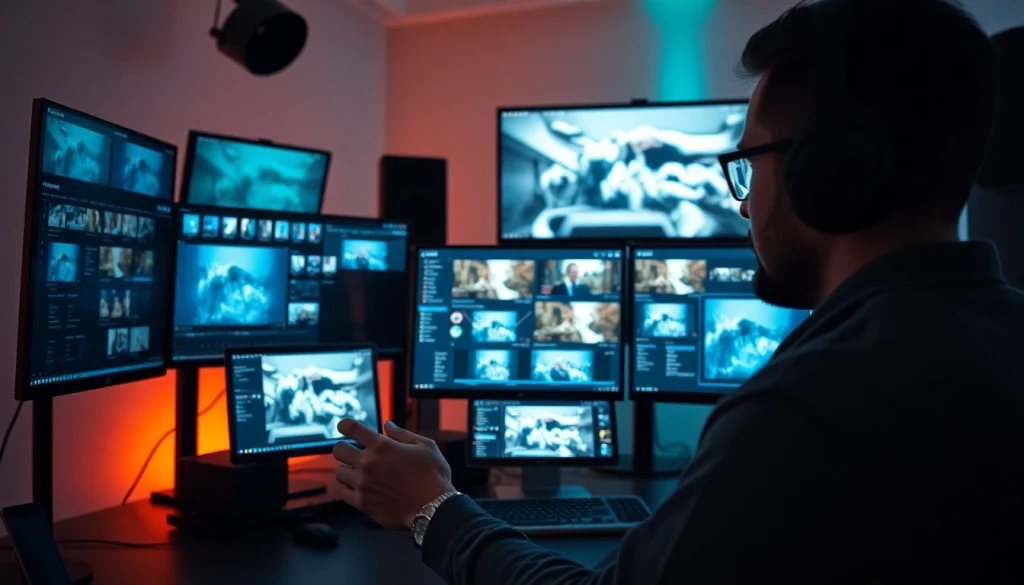Understanding Corporate Video Editing
What is Corporate Video Editing?
Corporate video editing is the process of refining raw video footage to create finished videos that display a corporate identity, convey messages, and fulfill business objectives. This type of editing encompasses various video formats, including promotional videos, training videos, internal communications, and more. The editing process transforms simple recordings into compelling narratives, designed to engage audiences effectively. By structuring visuals alongside audio elements, graphics, and effects, corporate video editors craft stories that resonate with viewers, aligning with the strategic goals of the organization.
Importance of Corporate Video Editing
In today’s digital landscape, the importance of corporate video editing cannot be overstated. As organizations leverage visual content for marketing and communication, the need for high-quality, impactful videos becomes paramount. Well-edited corporate videos can:
- Enhance Brand Image: Professional video editing also reflects the company’s brand values and aesthetic, fostering a positive impression among stakeholders.
- Improve Engagement: Engaging content is more likely to capture audience attention online, leading to higher retention rates and overall effectiveness.
- Effective Communication: Edited videos convey messages more clearly, providing a structured approach to information dissemination.
- Versatile Usage: Edited videos can serve multiple purposes, from internal training to customer-facing marketing, enhancing return on investment.
Key Elements of Successful Corporate Videos
Understanding the key elements of successful corporate videos is crucial for any video editing project. Key elements include:
- Storytelling: All great videos tell a story. Defining a clear narrative arc helps maintain viewer engagement and communicates the intended message more effectively.
- Visual Quality: High-quality visuals—sharp resolution, proper lighting, and appealing composition—make a significant difference in retaining viewer interest.
- Sound Design: Sound effects, background music, and clear voiceovers enhance the overall viewing experience and can evoke emotional responses.
- Brand Consistency: Each video must adhere to the company’s branding guidelines regarding colors, logos, and messaging to maintain a cohesive brand identity.
Essential Tools for Corporate Video Editing
Video Editing Software for Corporates
The choice of software can significantly impact the editing process. Several options cater specifically to corporate needs:
- Adobe Premiere Pro: This industry-standard software is known for its cutting-edge editing tools and flexibility, making it suitable for professionals and corporations alike.
- Final Cut Pro: Particularly favored by Mac users, this software offers powerful editing options and an intuitive user interface.
- DaVinci Resolve: Renowned for its advanced color correction features, DaVinci Resolve also provides a robust editing suite, making it a great choice for high-quality corporate videos.
- Camtasia: Ideal for screen recording and instructional videos, Camtasia is user-friendly and helpful for creating training content.
Equipment Recommendations for Quality Footage
Great editing starts with quality footage. Invest in the following equipment to ensure high standards:
- Cameras: DSLRs like the Canon EOS series or mirrorless systems from Sony offer versatility and high image quality.
- Tripods and Stabilizers: Stability is crucial for professional footage. Use tripods, sliders, or gimbals to achieve smooth shots.
- Microphones: Audio quality is paramount. Invest in external microphones such as lavalier or shotgun mics to capture clear sound.
Building Your Editing Workspace
A well-organized editing workspace can enhance efficiency and productivity. Consider these elements:
- High-Performance Computer: Use machines with adequate processing power and sufficient RAM to handle high-resolution video files.
- Dual Monitors: A multi-monitor setup can make multitasking easier, allowing for smoother editing workflows.
- Ergonomic Furniture: Invest in comfortable chairs and desks that promote good posture during long editing sessions.
Types of Corporate Video Editing
Editing Promotional Videos Effectively
Promotional videos are vital for marketing strategies, showcasing products or services to potential customers. Editing these videos requires creativity and precision:
- Highlight Key Features: Use editing techniques such as cuts and transitions to emphasize the unique selling points of products or services.
- Incorporate Engaging Visuals: B-roll footage and graphics should support the narrative, making data and benefits visually digestible.
- Strong Call to Action: End with a compelling call to action to guide viewers on the next steps they should take.
Crafting Training Video Content
Training videos educate employees on various processes and company policies. Effective editing for training content often includes:
- Clear Instructions: Use text overlays to reinforce key points and ensure that the instructions are easy to follow.
- Segmented Content: Break down long videos into chapters or segments for easier navigation and better retention.
- Real-Life Scenarios: Incorporate real-world examples or case studies to make the content relatable and practical.
Showcasing Corporate Brand Values
Videos that encapsulate corporate values and culture can strengthen a company’s image. Editing these videos involves:
- Authentic Storytelling: Highlight employee testimonials and experiences to connect emotionally with viewers.
- Visual Branding: Use consistent imagery, colors, and logos throughout to reinforce brand identity.
- Community Engagement: Show corporate social responsibility efforts through engaging footage that showcases events or initiatives.
Best Practices in Corporate Video Editing
Editing Techniques to Enhance Engagement
Using specific editing techniques can significantly enhance viewer engagement:
- Jump Cuts: Utilize jump cuts to maintain pacing and energy in your video, particularly for interviews or testimonials.
- Smooth Transitions: Experiment with different transitions to maintain a professional look while aiding in the story’s flow.
- Text and Graphics: Use overlay text and graphics to provide additional context and emphasize critical points.
Maintaining Brand Consistency in Videos
To preserve a coherent brand identity across videos, follow these best practices:
- Brand Guidelines: Develop a comprehensive style guide that outlines color schemes, fonts, and logo placements.
- Consistent Voice: Use a consistent tone of voice in voiceover and textual content to reflect the brand effectively.
- Review Process: Implement a rigorous review and feedback process to ensure adherence to guidelines before the final video release.
Tips for Streamlining the Editing Process
Efficient editing enhances productivity. Consider these tips:
- Organize Your Footage: Label and sort files by project to streamline the editing process and reduce search time.
- Create Templates: Develop templates for recurring video types, which can save time and maintain consistency.
- Work in Phases: Break the editing process into phases (rough cut, fine cut, final review) to manage tasks more efficiently.
Measuring Success in Corporate Video Editing
Key Performance Indicators for Video Effectiveness
To assess the success of corporate video editing efforts, utilize key performance indicators (KPIs), such as:
- View Count: Analyze the number of views to determine reach and audience interest.
- Engagement Rate: Monitor likes, shares, and comments to gauge viewer interaction.
- Conversion Rate: Track metrics on how many viewers take desired actions post-viewing, such as visiting a website or making a purchase.
Gathering Feedback and Making Improvements
Gathering feedback is essential for ongoing improvement in corporate video editing. Techniques include:
- Viewer Surveys: Implement surveys or polls to gather direct feedback from viewers regarding content quality and engagement.
- Analytics Tools: Use analytics tools to track performance data and identify areas for improvement.
- Team Review Sessions: Organize regular review sessions with project teams to discuss successes and challenges encountered during editing.
Case Studies of Successful Corporate Video Campaigns
Analyzing successful corporate video campaigns provides valuable insights into effective strategies. Consider:
- Case Study 1: A leading tech company used narrative storytelling and dynamic pacing to launch a product, resulting in a 40% increase in pre-orders compared to the previous year.
- Case Study 2: A corporate training video used real employee testimonials, which not only improved its view rate but also increased employee engagement and retention.
- Case Study 3: A nonprofit leveraged behind-the-scenes footage of its community initiatives, significantly raising awareness and donations after the video went viral online.
Corporate video editing is both an art and a science, requiring a deep understanding of storytelling, technical skills, and a strategic approach to brand communication. By mastering the intricacies of video editing, organizations can create impactful narratives that speak to their audiences and achieve significant business results. If you are looking to elevate your brand with effective corporate video editing, consider exploring tailored services from experts in the field, such as the resources available at Corporate Video Editing.


